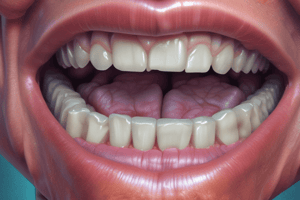Podcast
Questions and Answers
What is the purpose of the Extraoral and Intraoral Clinical Assessment?
What is the purpose of the Extraoral and Intraoral Clinical Assessment?
To ensure that a thorough assessment has been completed of the Head & Neck areas to provide client specific care.
Which of the following is an atypical finding during the assessment? (Select all that apply)
Which of the following is an atypical finding during the assessment? (Select all that apply)
- Freckles (correct)
- Moles (correct)
- Tattoos (correct)
- Needle marks
What is an abnormal finding?
What is an abnormal finding?
- A finding that could prove to be serious (correct)
- A normal finding
- A finding that is a variation from normal
- A typical healing response
All lesions indicate cancer.
All lesions indicate cancer.
More than 75% of head and neck cancers originate in the ______.
More than 75% of head and neck cancers originate in the ______.
What are the common risk factors associated with oral and oropharyngeal cancer?
What are the common risk factors associated with oral and oropharyngeal cancer?
What techniques are used in the assessment skills?
What techniques are used in the assessment skills?
Which of the following methods is NOT a type of palpation?
Which of the following methods is NOT a type of palpation?
List the common types of skin cancer mentioned.
List the common types of skin cancer mentioned.
What is a characteristic of a malignant lesion?
What is a characteristic of a malignant lesion?
Erythroplakia is a common finding in healthy tissue.
Erythroplakia is a common finding in healthy tissue.
Flashcards are hidden until you start studying
Study Notes
Extraoral and Intraoral Clinical Assessment
- Assessment aims to thoroughly examine the Head & Neck areas, ensuring patient-specific care and identifying any questionable areas.
- Dental hygienists are responsible for distinguishing between normal findings and abnormalities during examinations.
Lesion Terminology
- Lesion: Structural change due to injury or disease.
- Atypical Finding: Variation from normal that may or may not indicate pathology.
- Abnormal Finding: Potentially serious findings requiring further investigation.
Rationale for Examination
- Early detection of abnormalities can reveal underlying conditions such as:
- Thyroid disorders
- Eating disorders
- Nutritional deficiencies
- Sexually transmitted diseases
- Systemic conditions
Assessment Skills
- Observation, palpation, auscultation, and olfaction are key skills in clinical assessment.
- Various palpation techniques include:
- Digital, bidigital, manual, bimanual, bilateral, and circular compression.
Extraoral Assessment
- Normal findings include facial symmetry, firm skin, and typical pigmentation.
- Atypical findings may involve moles, scars, tattoos, and piercings.
- Abnormal findings may indicate drug use or trauma from domestic violence.
Sequence of Extraoral Examination
- Overall appraisal of the patient includes evaluation of the:
- Face
- Skin
- Eyes
- Nodes and glands
- Temporomandibular joint
- Lips
Specific Areas of Examination
- Detailed assessments cover regions such as:
- Frontal, parietal, temporal, nasal, infraorbital, buccal, and mental regions.
Lymph Nodes
- Palpable lymph nodes can indicate active disease processes and check if conditions have spread.
Intraoral Examination
- Comprehensive evaluation examines:
- Lips and intraoral mucosa
- Palate and uvula
- Tongue and floor of mouth
- Saliva consistency
Oral and Oropharyngeal Cancer
- Over 75% of head and neck cancers originate in the oral cavity; increasing pharyngeal cancer cases are associated with HPV.
- Strong risk factors: Tobacco use, alcohol abuse, and HPV infection.
- Common sites for oral squamous cell carcinoma:
- Lower lip, lateral tongue, floor of mouth, and soft palate.
Skin Cancer Types
- Basal cell carcinoma (BCC) and squamous cell carcinoma (SCC) are the most prevalent; melanoma is less common and can be fatal.
Cancer Progression Indicators
- Signs of malignancy include:
- Non-healing lesions, changes in color/shape/size, and presence of erythroplakia or leukoplakia.
Patient Education and Self-Examination
- Encourage patients to review their risk factors and recognize common cancer symptoms.
Documentation and Description of Findings
- Accurate documentation includes:
- Location, size, color changes, texture, mobility, consistency, and symptomatology.
Lesion Characteristics
- Key terminologies include:
- Elevated, depressed, and flat lesions, along with blisterform and nonblisterform categories.
Clinical Recommendations
- Update histories and conduct thorough extra/intraoral exams for adults; innocuous lesions can be monitored while suspicious ones warrant biopsy.
- Cytologic adjuncts may be utilized if a patient declines biopsy.
Studying That Suits You
Use AI to generate personalized quizzes and flashcards to suit your learning preferences.




